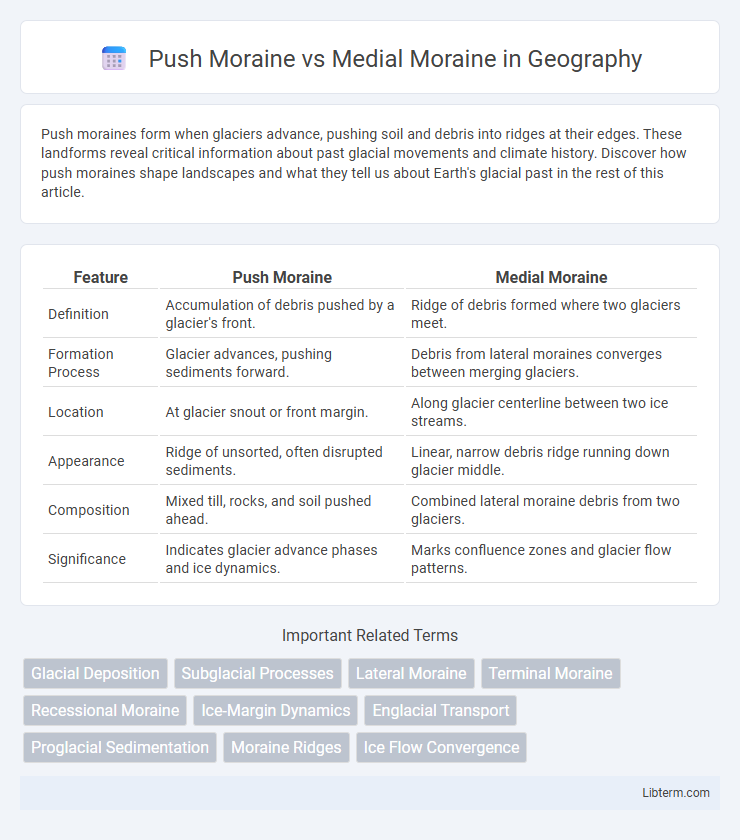Push moraines form when glaciers advance, pushing soil and debris into ridges at their edges. These landforms reveal critical information about past glacial movements and climate history. Discover how push moraines shape landscapes and what they tell us about Earth's glacial past in the rest of this article.
Table of Comparison
| Feature | Push Moraine | Medial Moraine |
|---|---|---|
| Definition | Accumulation of debris pushed by a glacier's front. | Ridge of debris formed where two glaciers meet. |
| Formation Process | Glacier advances, pushing sediments forward. | Debris from lateral moraines converges between merging glaciers. |
| Location | At glacier snout or front margin. | Along glacier centerline between two ice streams. |
| Appearance | Ridge of unsorted, often disrupted sediments. | Linear, narrow debris ridge running down glacier middle. |
| Composition | Mixed till, rocks, and soil pushed ahead. | Combined lateral moraine debris from two glaciers. |
| Significance | Indicates glacier advance phases and ice dynamics. | Marks confluence zones and glacier flow patterns. |
Introduction to Push and Medial Moraines
Push moraines form when advancing glaciers push sediment and debris forward, creating ridges composed primarily of unsorted till. Medial moraines develop in the center of a glacier, originating from the merging of lateral moraines as two glaciers converge and deposit debris along the middle of the ice flow. These distinct moraine types provide crucial insights into glacial movement and sediment transport processes.
Definition of Push Moraine
A push moraine is a glacial landform created when advancing ice sheets physically push and pile up sediments and debris at their front, resulting in a ridge of mixed till. Unlike a medial moraine, which forms from the merging of lateral moraines between two glaciers, a push moraine specifically originates from the compressive force exerted by glacier movement. This distinctive feature indicates past glacier dynamics and ice margin fluctuations in glaciated landscapes.
Definition of Medial Moraine
A medial moraine forms when two glaciers converge, causing debris from their lateral moraines to accumulate in a ridge along the center of the combined glacier. In contrast, a push moraine results from the forward movement of a glacier that actively bulldozes and piles up sediment at its terminus. Medial moraines are critical indicators of glacier dynamics and provide insights into past glacial movements and interactions.
Formation Processes of Push Moraine
Push moraines form through glacial advance, where the ice sheet physically pushes and deforms sediment and debris at its snout, creating a ridged accumulation of till. This process contrasts with medial moraines, which develop from the merging of lateral moraines as two glaciers converge, resulting in a central ridge of debris on the glacier surface. The formation of push moraines is strongly influenced by the glacier's dynamic movement and the availability of unconsolidated sediment at its terminus.
Formation Processes of Medial Moraine
Medial moraines form when two glaciers with lateral moraines merge, causing debris from their sides to accumulate in a central ridge along the combined glacier's surface. This process contrasts with push moraines, which develop from the glacier actively pushing and deforming sediment at its terminus due to ice movement. The formation of medial moraines highlights the dynamic interaction between converging ice flows and transported debris, resulting in distinct linear features tracing glacier confluence zones.
Key Differences Between Push and Medial Moraines
Push moraines form at the glacier's leading edge from debris pushed forward by the glacier's advancing ice, characterized by ridges of unconsolidated sediments. Medial moraines occur within the glacier's body where two glaciers merge, resulting in linear accumulations of debris carried on the ice surface. Key differences include their formation location--push moraines at the glacier terminus, medial moraines along the glacier centerline--and their composition and morphology, with push moraines generally composed of mixed sediments and medial moraines primarily consisting of material from the lateral moraines of merging glaciers.
Geological Significance of Push Moraine
Push moraines form when advancing glaciers physically shove sediment and debris into ridges, providing crucial evidence of glacier dynamics and past ice movement. These formations reveal the stress and pressure exerted by glacial ice, offering insights into the timing and extent of glacial advances during the Quaternary period. Unlike medial moraines, which are composed of debris from merging glaciers, push moraines directly indicate the mechanical force and directional flow of glacial ice, making them significant markers in reconstructing paleoclimate and glacial history.
Geological Significance of Medial Moraine
Medial moraines form when two glaciers converge, combining their lateral moraines into a distinctive ridge of debris that provides critical evidence of glacier movement and interaction. Unlike push moraines, which result from the glacier's forward thrusting of sediments, medial moraines record the glacier's flow dynamics and ice merging processes. Geologically, medial moraines are significant for reconstructing past glacier extents and understanding glacier dynamics in mountainous regions.
Real-World Examples of Push and Medial Moraines
Push moraines form when advancing glaciers shove earth and rocks into ridges, exemplified by the Long Island moraine in New York, created during the last Ice Age. Medial moraines appear as dark stripes on glaciers, formed when two glaciers merge and their lateral moraines combine, notably observed on the Khumbu Glacier in Nepal. These distinct glacial features provide valuable evidence of past glacier movement and interaction in diverse environments.
Summary and Conclusion
Push moraines form when advancing glaciers push debris forward, creating ridges at the glacier's snout, characterized by unsorted, heterogeneous material. Medial moraines develop as linear accumulations of debris between two converging glaciers, composed primarily of rocky material carried along the glacier's center. Understanding the formation and composition differences between push and medial moraines clarifies glacier dynamics and sediment transport processes.
Push Moraine Infographic

 libterm.com
libterm.com